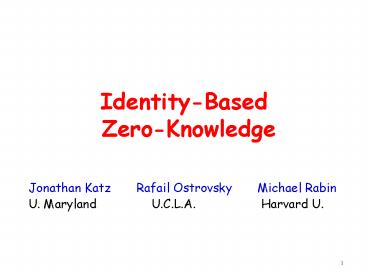IdentityBased ZeroKnowledge - PowerPoint PPT Presentation
Title:
IdentityBased ZeroKnowledge
Description:
How easy is it to construct? ... given (x,w,id) we construct ID-ZK: as follows: ... Claim 4: assuming any ID-ZK we can construct non-mall NIZK ... – PowerPoint PPT presentation
Number of Views:65
Avg rating:3.0/5.0
Title: IdentityBased ZeroKnowledge
1
Identity-Based Zero-Knowledge
Jonathan Katz Rafail Ostrovsky
Michael Rabin U. Maryland U.C.L.A.
Harvard U.
2
History recall original ZK motivation of GMR
- Prover can interactively convince verifier that x
is in L - Later, verifier can not convince someone else
- This prevents off-line plagiarism (i.e. Verifier
later claiming the proof as his own).
3
What about on-line Adv?
- Verifier can play man-in-the-middle
- Handled by the designated verifier proofs
- Jackobson,Sako, Impagliazzo, others
- This LIMITS the dissemination of proofs!
4
What we want
- To publish the proofs as widely as possible with
the authors names - Prevent plagiarism
- So, why not use NIZK?
5
NIZK reminder BFM
- Common reference string (R.S.)
- Prover sends a single message
- Its transferable
- Its ZK
- Can simulate the same view BDPM
- Can simulate with the same R.S. DDOPS
6
So are we done?
- Any verifier can take a NIZK proof, and either
- change it a bit, but still keep it valid or
- (The first point can be addressed with
non-malleable NIZK DDNSDDPOS) - claim it as his own and simply copy
7
Non-Malleable NIZK
- Non-malleability DDN can not constructed
related encrypted msg - Non-malleability for NIZK SDDOPS whatever
the verifier can prove after seeing a prove, it
can do without seeing the proof - Technical points
- (1) generation of CRS
- (2) 1 thm vs. many theorems
- (3) adaptivity
- (4) adv. challenges and the guarantees
- So, use the strongest def, are we done?
8
What is the def. of preventing plagiarism?
- You have an NP theorem and a witness
- You want is transferable
- You have your name (id) as part of it
- Want to bind the proof to your name (id) such
that nobody can change the proof to a different
id
9
ID-ZK
- This talk we concentrate on NIZK (but the notion
applies to interactive setting as well) - A new notion NIZK with extractable identity
- Prover(id,x,w,CRS) ? proof
- 2 public algs
- check correctness
- extract id from proof
- ZK for all x in L, and all id, can generate comp
indist. View. (1 thm or multiple thms). - Sound (w.h.p. can not cheat)
10
Security of ID-ZK
- Sound
- Can not change identities
- Informally no poly-time Adv. Can take one or
several ID-ZK proofs, and construct a proof for a
new id of an interesting theorem - Interesting ? something can Adv. Could not do
without any help.
11
Security of ID-ZK (cont.)
- NIZK with extractable identity is ID-ZK if
- Adv asks for ID-ZK proofs of different theorems,
and different ids - Adv comes up with a proof of a thm with a new id
- Simulator can output comp. indist. Distribution
of thms with new id without any ID-ZK proofs. - again several variants of what Adv can ask, the
strongest is simulation-soundness
12
Remarks about the model
- PK-infrastructure does it help? (i.e. what if
the prover signs his proof?) - No, the adv can just get rid of the signature and
substitute his own!
13
Remarks about the model (cont.)
- NIZK with a single random string what does
security mean? (since simulator must have a
trapdoor info) - The point is that we can do the proof without the
trapdoor if there is an adv who can cheat, the
proof implies that we can use it to derive the
contradiction!
14
How easy is it to construct?
- Also, what is the connection to NIZK in the
non-interactive setting?
15
Why not use non-mall NIZK?
- Claim 1 there exists non-malleable NIZK proofs
which are not ID-ZK. - Claim2 there exists ID-ZK NIZK proofs that are
not non-malleable NIZK.
16
Why not use non-mall NIZK?
- Claim 1 there exists non-malleable NIZK proofs
which are not ID-ZK. - Standard non-mall NIZK do not have any ID. I can
simply copy the proof and claim it as my own - Remark DDN showed how with IDs non-mall NIZK
is easier to build, this is different!
17
Why not use non-mall NIZK?
- Claim2 there exists ID-ZK proofs that are not
non-malleable. - Proof idea take ID-ZK proof, where we attach the
first (undetermined) bit. This is malleable, but
can still be shown to be ID-ZK!
18
ID-ZK are closely related to non-mall NIZK
- Claim 3 assuming any non-mall NIZK we can
construct ID-ZK NIZK. - Claim 4 assuming any ID-ZK NIZK, we can
construct non-mall NIZK
19
ID-ZK are closely related to non-mall NIZK
- Claim 3 assuming any non-mall NIZK we can
construct ID-ZK - given (x,w,id) we construct ID-ZK as follows
- Define langue L(x,id) either x in L or (a new
portion) of CRS is a commitment to id. - Send is ID-ZK (id, non-mall-NIZK for L).
- Intuition if can create new id, violates
non-malleability!
20
ID-ZK are closely related to non-mall NIZK
- Claim 4 assuming any ID-ZK we can construct
non-mall NIZK - Proof idea use as ID a signature public-key,
i.e. id PK. - Let B id-zk(id,x in L)
- Send (id B signpk(B))
- Note same proof-structure works for interactive
case.
21
CONCLUSIONS
- Many previous works (including DDN) used
identities in constructions but this is the first
formal definition of binding names to proofs. - Our definition is the most interesting part,
seems to be a useful building block. - What about application-specific efficient
implementations?































